Financial Accounting Analysis: A Case Study of Argo Investments
VerifiedAdded on 2023/06/12
|7
|1459
|256
Case Study
AI Summary
This case study provides a comprehensive financial analysis of Argo Investments, focusing on key areas such as investment goals, risk levels, past performance, and fund fees. It examines the relevance of information for investors, fair presentation of financial statements using AASB 136 and AASB 101/IAS 1, and accounting estimates in accordance with AASB 108. The analysis covers revenue recognition criteria, impairment testing, and the necessary disclosures related to changes in accounting policies, providing a detailed overview of Argo Investments' financial practices and reporting requirements. This student-contributed document is available on Desklib, where students can find a wide array of solved assignments and study resources.
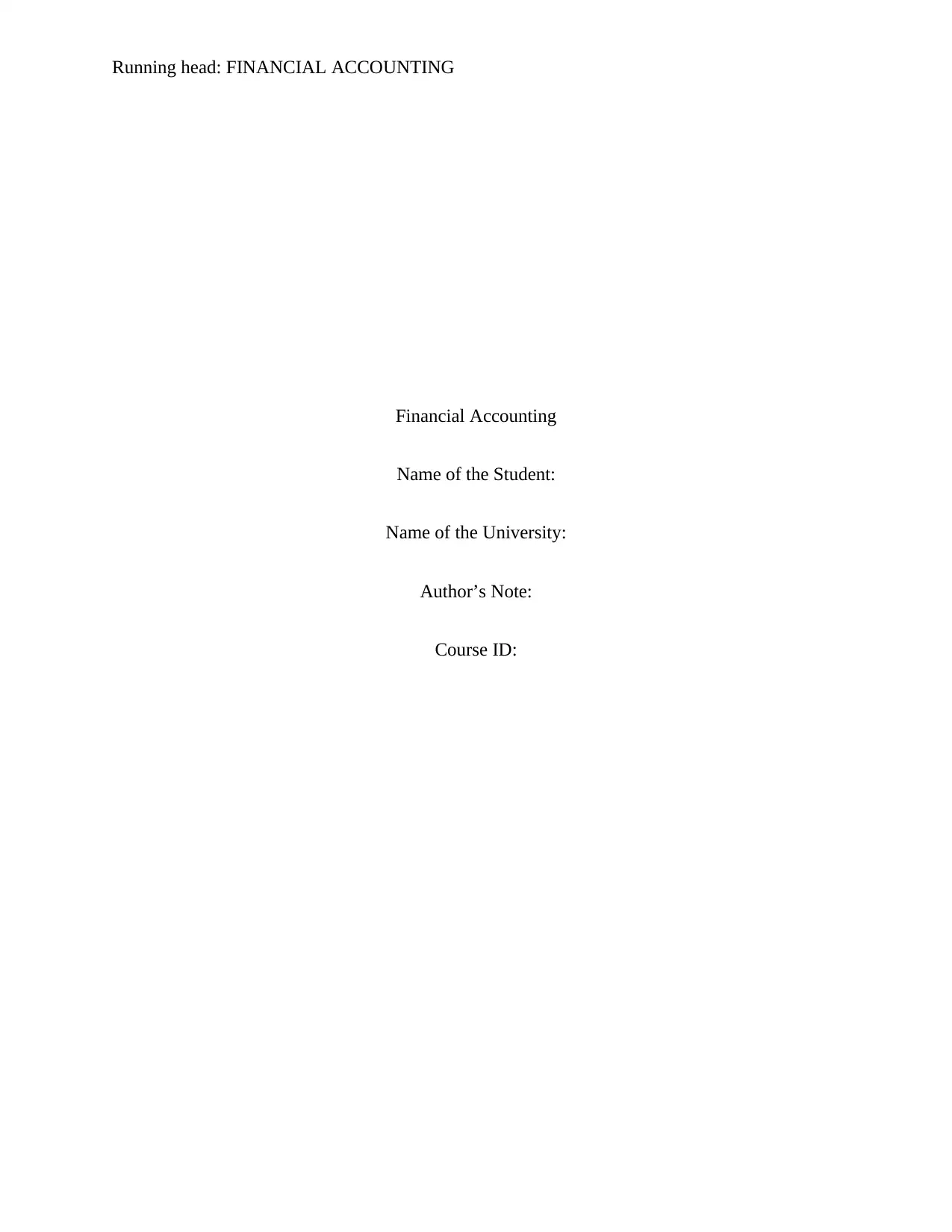
Running head: FINANCIAL ACCOUNTING
Financial Accounting
Name of the Student:
Name of the University:
Author’s Note:
Course ID:
Financial Accounting
Name of the Student:
Name of the University:
Author’s Note:
Course ID:
Paraphrase This Document
Need a fresh take? Get an instant paraphrase of this document with our AI Paraphraser
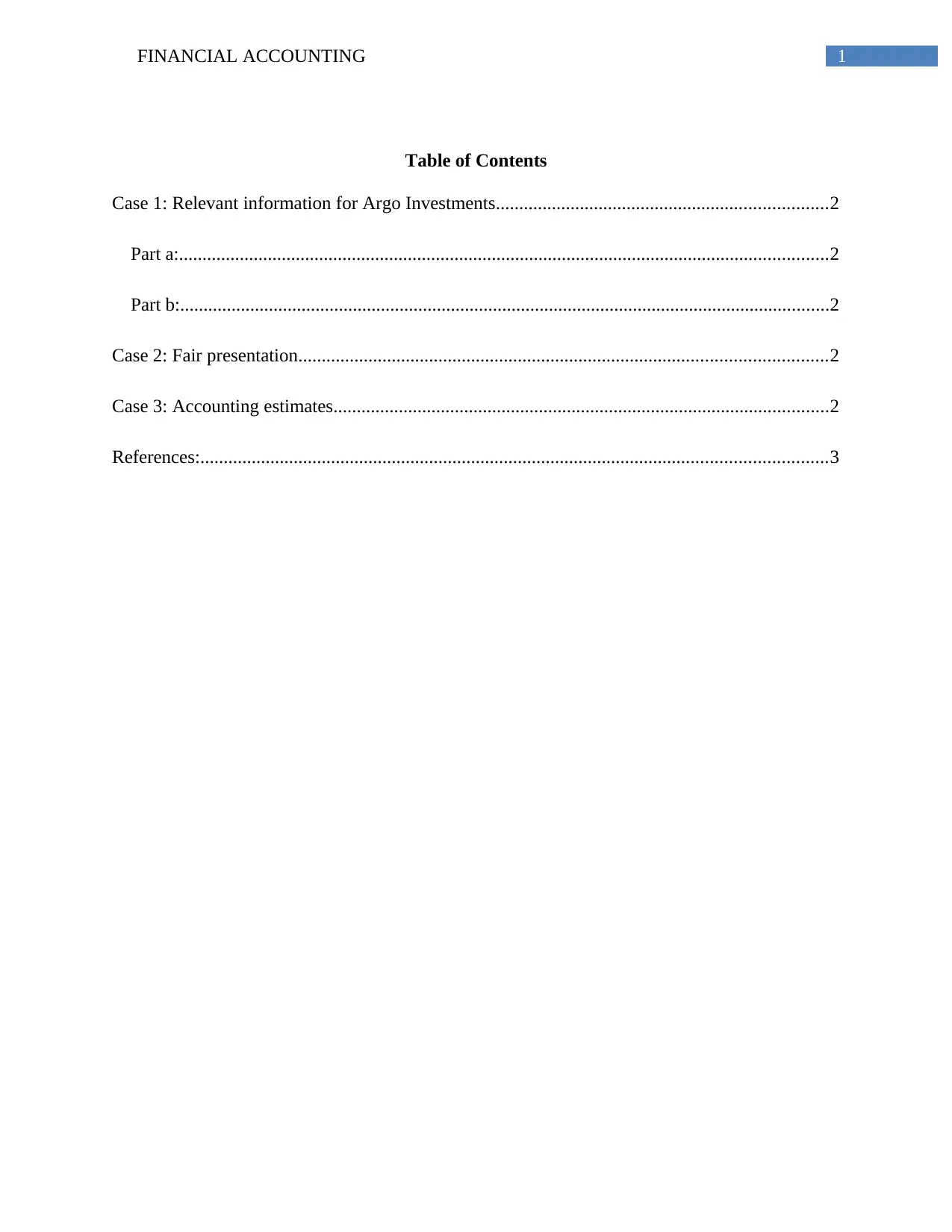
1FINANCIAL ACCOUNTING
Table of Contents
Case 1: Relevant information for Argo Investments.......................................................................2
Part a:...........................................................................................................................................2
Part b:...........................................................................................................................................2
Case 2: Fair presentation.................................................................................................................2
Case 3: Accounting estimates..........................................................................................................2
References:......................................................................................................................................3
Table of Contents
Case 1: Relevant information for Argo Investments.......................................................................2
Part a:...........................................................................................................................................2
Part b:...........................................................................................................................................2
Case 2: Fair presentation.................................................................................................................2
Case 3: Accounting estimates..........................................................................................................2
References:......................................................................................................................................3

2FINANCIAL ACCOUNTING
Case 1: Relevant information for Argo Investments
Part a:
There are four significant areas for the investors that they need to examine for assessing
the financial performance of Argo Investments and they include goals and investment strategy,
risk level related to the fund, previous performance and fund fees.
Goals and investment strategy:
It has been identified from the annual report of Argo Investments that it aims to
maximise long-term returns to the shareholders by maintaining effective balance of capital and
dividend growth from a diversified investment portfolio in Australia (Argoinvestments.com.au,
2018). As at 30 June 2017, its market capitalisation stood at $5.3 billion and its total assets have
been $5.4 billion. Instead of providing greater returns by taking high risks, it provides
unswerving tax effective income and long-term capital growth through investment in different
types of securities.
Risk level of the fund:
Certain factors that affect the risk level of a fund include economic growth rate, exchange
rate, regulatory changes, taxation levels, capital strength, industrial trends, competitive behaviour
and others (Yong, Lim & Tan, 2016). Due to the changing nature of these factors, it becomes
very difficult in anticipating the future performance of Agro Investments. In order to minimise
the negative effects of the risks, Agro manages its funds conservatively and the portfolio
holdings diversification enables in reducing the earnings of the organisation and fluctuations in
capital. This would help the potential investors to identify a fund having an acceptable risk level.
Case 1: Relevant information for Argo Investments
Part a:
There are four significant areas for the investors that they need to examine for assessing
the financial performance of Argo Investments and they include goals and investment strategy,
risk level related to the fund, previous performance and fund fees.
Goals and investment strategy:
It has been identified from the annual report of Argo Investments that it aims to
maximise long-term returns to the shareholders by maintaining effective balance of capital and
dividend growth from a diversified investment portfolio in Australia (Argoinvestments.com.au,
2018). As at 30 June 2017, its market capitalisation stood at $5.3 billion and its total assets have
been $5.4 billion. Instead of providing greater returns by taking high risks, it provides
unswerving tax effective income and long-term capital growth through investment in different
types of securities.
Risk level of the fund:
Certain factors that affect the risk level of a fund include economic growth rate, exchange
rate, regulatory changes, taxation levels, capital strength, industrial trends, competitive behaviour
and others (Yong, Lim & Tan, 2016). Due to the changing nature of these factors, it becomes
very difficult in anticipating the future performance of Agro Investments. In order to minimise
the negative effects of the risks, Agro manages its funds conservatively and the portfolio
holdings diversification enables in reducing the earnings of the organisation and fluctuations in
capital. This would help the potential investors to identify a fund having an acceptable risk level.
⊘ This is a preview!⊘
Do you want full access?
Subscribe today to unlock all pages.

Trusted by 1+ million students worldwide
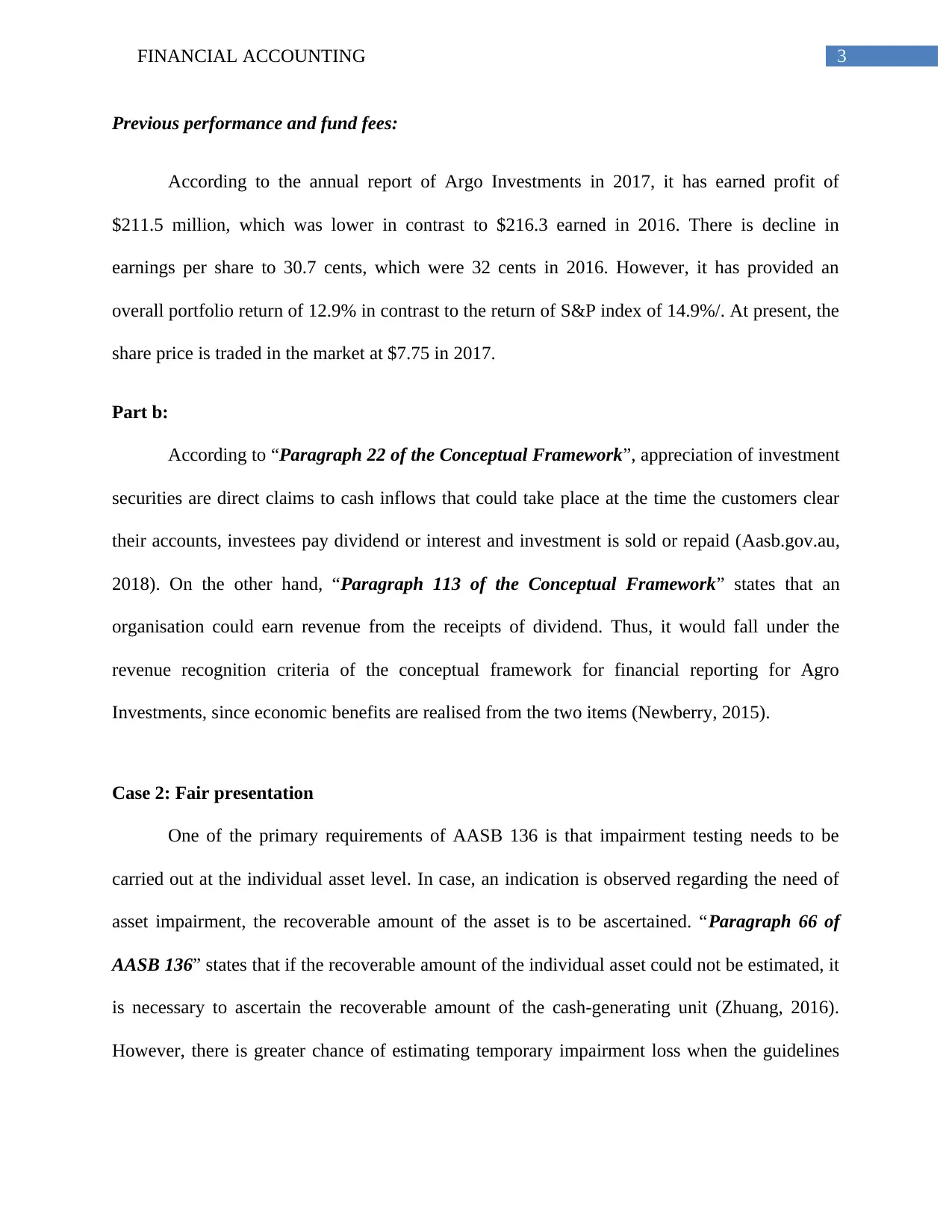
3FINANCIAL ACCOUNTING
Previous performance and fund fees:
According to the annual report of Argo Investments in 2017, it has earned profit of
$211.5 million, which was lower in contrast to $216.3 earned in 2016. There is decline in
earnings per share to 30.7 cents, which were 32 cents in 2016. However, it has provided an
overall portfolio return of 12.9% in contrast to the return of S&P index of 14.9%/. At present, the
share price is traded in the market at $7.75 in 2017.
Part b:
According to “Paragraph 22 of the Conceptual Framework”, appreciation of investment
securities are direct claims to cash inflows that could take place at the time the customers clear
their accounts, investees pay dividend or interest and investment is sold or repaid (Aasb.gov.au,
2018). On the other hand, “Paragraph 113 of the Conceptual Framework” states that an
organisation could earn revenue from the receipts of dividend. Thus, it would fall under the
revenue recognition criteria of the conceptual framework for financial reporting for Agro
Investments, since economic benefits are realised from the two items (Newberry, 2015).
Case 2: Fair presentation
One of the primary requirements of AASB 136 is that impairment testing needs to be
carried out at the individual asset level. In case, an indication is observed regarding the need of
asset impairment, the recoverable amount of the asset is to be ascertained. “Paragraph 66 of
AASB 136” states that if the recoverable amount of the individual asset could not be estimated, it
is necessary to ascertain the recoverable amount of the cash-generating unit (Zhuang, 2016).
However, there is greater chance of estimating temporary impairment loss when the guidelines
Previous performance and fund fees:
According to the annual report of Argo Investments in 2017, it has earned profit of
$211.5 million, which was lower in contrast to $216.3 earned in 2016. There is decline in
earnings per share to 30.7 cents, which were 32 cents in 2016. However, it has provided an
overall portfolio return of 12.9% in contrast to the return of S&P index of 14.9%/. At present, the
share price is traded in the market at $7.75 in 2017.
Part b:
According to “Paragraph 22 of the Conceptual Framework”, appreciation of investment
securities are direct claims to cash inflows that could take place at the time the customers clear
their accounts, investees pay dividend or interest and investment is sold or repaid (Aasb.gov.au,
2018). On the other hand, “Paragraph 113 of the Conceptual Framework” states that an
organisation could earn revenue from the receipts of dividend. Thus, it would fall under the
revenue recognition criteria of the conceptual framework for financial reporting for Agro
Investments, since economic benefits are realised from the two items (Newberry, 2015).
Case 2: Fair presentation
One of the primary requirements of AASB 136 is that impairment testing needs to be
carried out at the individual asset level. In case, an indication is observed regarding the need of
asset impairment, the recoverable amount of the asset is to be ascertained. “Paragraph 66 of
AASB 136” states that if the recoverable amount of the individual asset could not be estimated, it
is necessary to ascertain the recoverable amount of the cash-generating unit (Zhuang, 2016).
However, there is greater chance of estimating temporary impairment loss when the guidelines
Paraphrase This Document
Need a fresh take? Get an instant paraphrase of this document with our AI Paraphraser
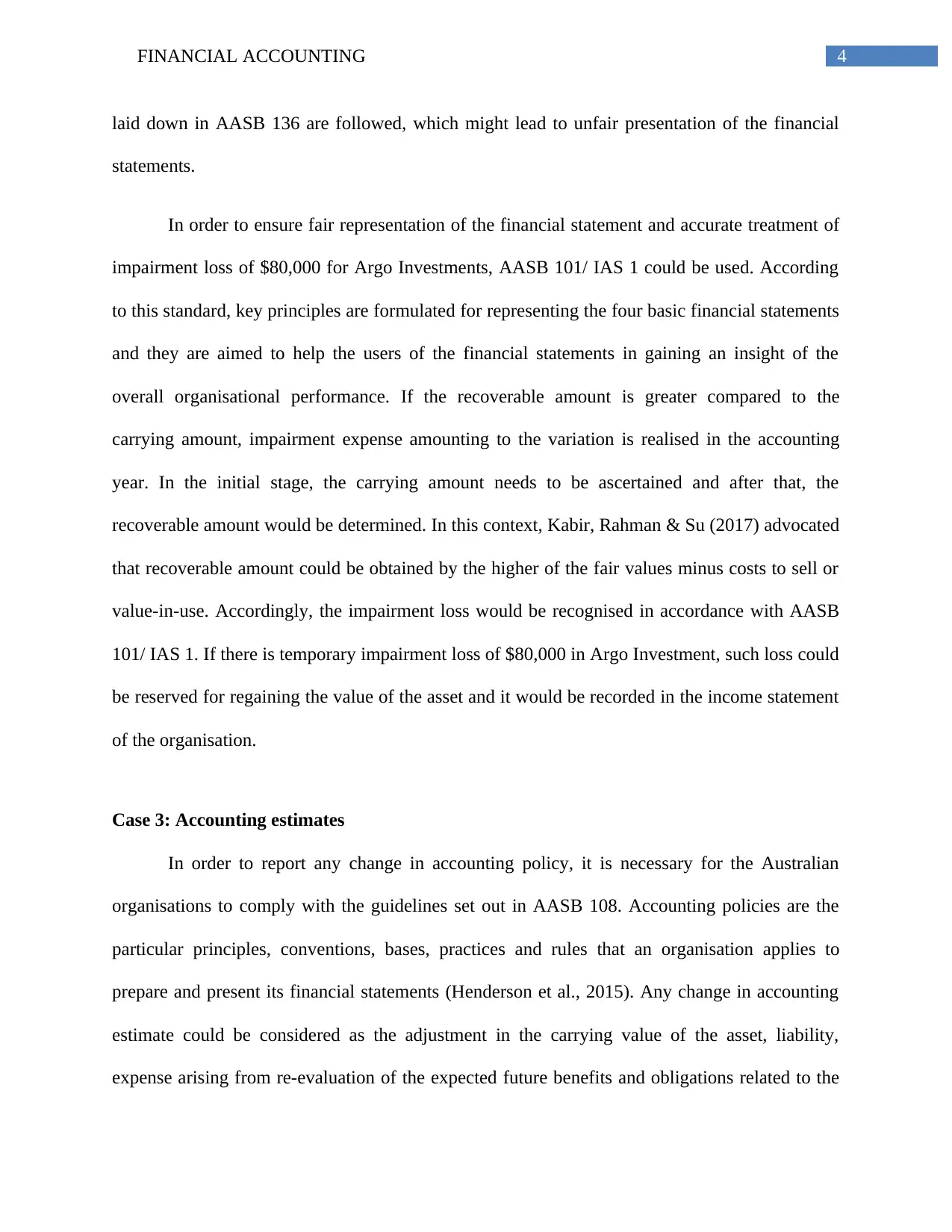
4FINANCIAL ACCOUNTING
laid down in AASB 136 are followed, which might lead to unfair presentation of the financial
statements.
In order to ensure fair representation of the financial statement and accurate treatment of
impairment loss of $80,000 for Argo Investments, AASB 101/ IAS 1 could be used. According
to this standard, key principles are formulated for representing the four basic financial statements
and they are aimed to help the users of the financial statements in gaining an insight of the
overall organisational performance. If the recoverable amount is greater compared to the
carrying amount, impairment expense amounting to the variation is realised in the accounting
year. In the initial stage, the carrying amount needs to be ascertained and after that, the
recoverable amount would be determined. In this context, Kabir, Rahman & Su (2017) advocated
that recoverable amount could be obtained by the higher of the fair values minus costs to sell or
value-in-use. Accordingly, the impairment loss would be recognised in accordance with AASB
101/ IAS 1. If there is temporary impairment loss of $80,000 in Argo Investment, such loss could
be reserved for regaining the value of the asset and it would be recorded in the income statement
of the organisation.
Case 3: Accounting estimates
In order to report any change in accounting policy, it is necessary for the Australian
organisations to comply with the guidelines set out in AASB 108. Accounting policies are the
particular principles, conventions, bases, practices and rules that an organisation applies to
prepare and present its financial statements (Henderson et al., 2015). Any change in accounting
estimate could be considered as the adjustment in the carrying value of the asset, liability,
expense arising from re-evaluation of the expected future benefits and obligations related to the
laid down in AASB 136 are followed, which might lead to unfair presentation of the financial
statements.
In order to ensure fair representation of the financial statement and accurate treatment of
impairment loss of $80,000 for Argo Investments, AASB 101/ IAS 1 could be used. According
to this standard, key principles are formulated for representing the four basic financial statements
and they are aimed to help the users of the financial statements in gaining an insight of the
overall organisational performance. If the recoverable amount is greater compared to the
carrying amount, impairment expense amounting to the variation is realised in the accounting
year. In the initial stage, the carrying amount needs to be ascertained and after that, the
recoverable amount would be determined. In this context, Kabir, Rahman & Su (2017) advocated
that recoverable amount could be obtained by the higher of the fair values minus costs to sell or
value-in-use. Accordingly, the impairment loss would be recognised in accordance with AASB
101/ IAS 1. If there is temporary impairment loss of $80,000 in Argo Investment, such loss could
be reserved for regaining the value of the asset and it would be recorded in the income statement
of the organisation.
Case 3: Accounting estimates
In order to report any change in accounting policy, it is necessary for the Australian
organisations to comply with the guidelines set out in AASB 108. Accounting policies are the
particular principles, conventions, bases, practices and rules that an organisation applies to
prepare and present its financial statements (Henderson et al., 2015). Any change in accounting
estimate could be considered as the adjustment in the carrying value of the asset, liability,
expense arising from re-evaluation of the expected future benefits and obligations related to the
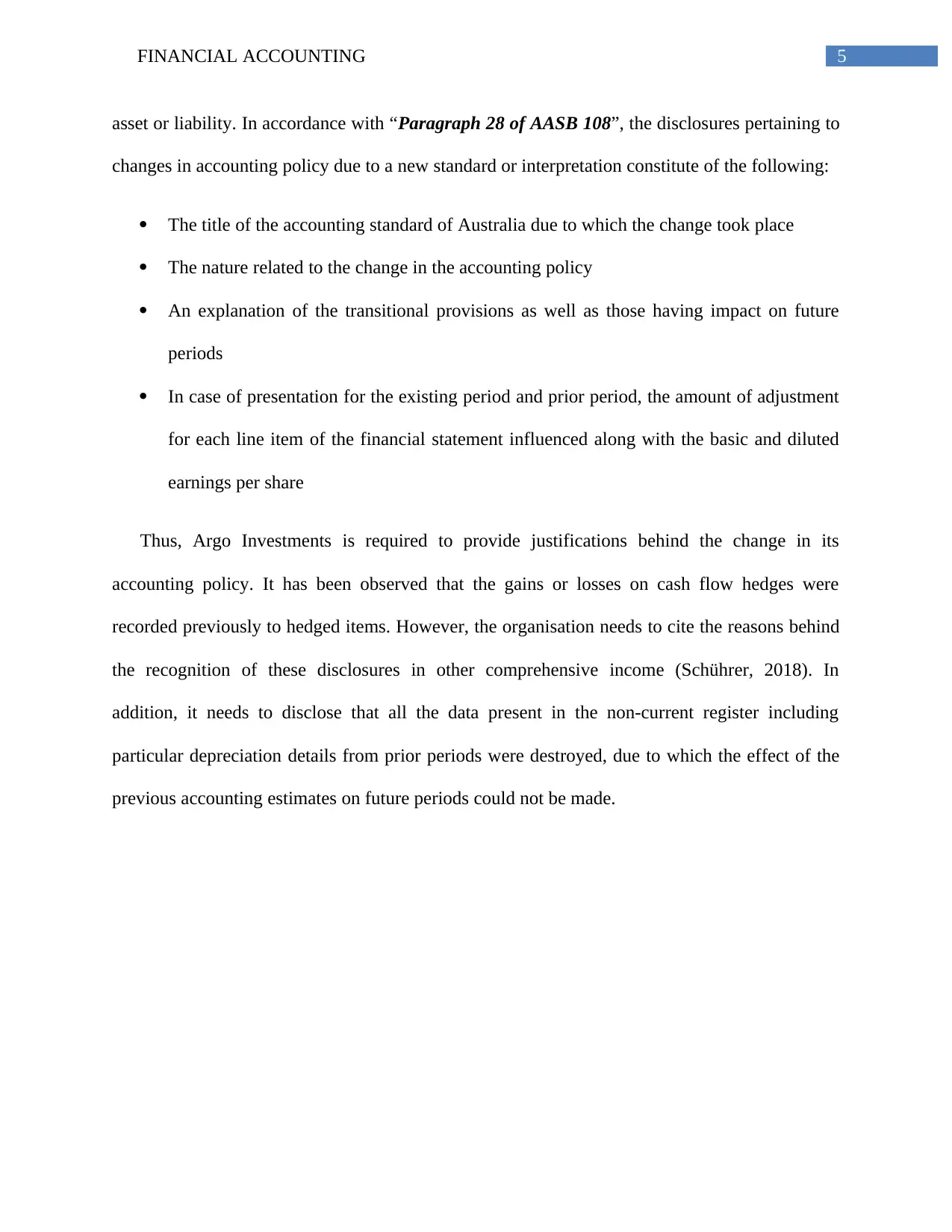
5FINANCIAL ACCOUNTING
asset or liability. In accordance with “Paragraph 28 of AASB 108”, the disclosures pertaining to
changes in accounting policy due to a new standard or interpretation constitute of the following:
The title of the accounting standard of Australia due to which the change took place
The nature related to the change in the accounting policy
An explanation of the transitional provisions as well as those having impact on future
periods
In case of presentation for the existing period and prior period, the amount of adjustment
for each line item of the financial statement influenced along with the basic and diluted
earnings per share
Thus, Argo Investments is required to provide justifications behind the change in its
accounting policy. It has been observed that the gains or losses on cash flow hedges were
recorded previously to hedged items. However, the organisation needs to cite the reasons behind
the recognition of these disclosures in other comprehensive income (Schührer, 2018). In
addition, it needs to disclose that all the data present in the non-current register including
particular depreciation details from prior periods were destroyed, due to which the effect of the
previous accounting estimates on future periods could not be made.
asset or liability. In accordance with “Paragraph 28 of AASB 108”, the disclosures pertaining to
changes in accounting policy due to a new standard or interpretation constitute of the following:
The title of the accounting standard of Australia due to which the change took place
The nature related to the change in the accounting policy
An explanation of the transitional provisions as well as those having impact on future
periods
In case of presentation for the existing period and prior period, the amount of adjustment
for each line item of the financial statement influenced along with the basic and diluted
earnings per share
Thus, Argo Investments is required to provide justifications behind the change in its
accounting policy. It has been observed that the gains or losses on cash flow hedges were
recorded previously to hedged items. However, the organisation needs to cite the reasons behind
the recognition of these disclosures in other comprehensive income (Schührer, 2018). In
addition, it needs to disclose that all the data present in the non-current register including
particular depreciation details from prior periods were destroyed, due to which the effect of the
previous accounting estimates on future periods could not be made.
⊘ This is a preview!⊘
Do you want full access?
Subscribe today to unlock all pages.

Trusted by 1+ million students worldwide
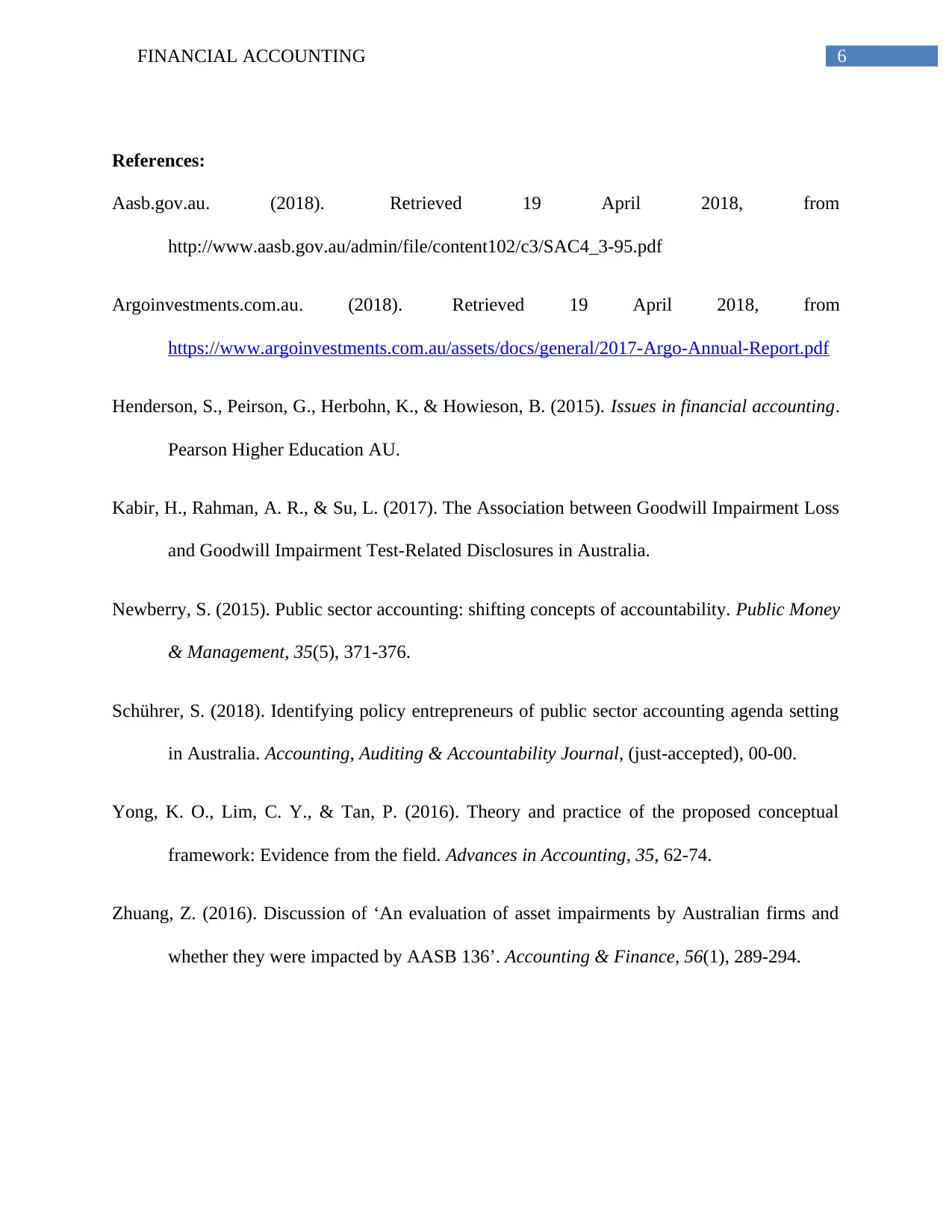
6FINANCIAL ACCOUNTING
References:
Aasb.gov.au. (2018). Retrieved 19 April 2018, from
http://www.aasb.gov.au/admin/file/content102/c3/SAC4_3-95.pdf
Argoinvestments.com.au. (2018). Retrieved 19 April 2018, from
https://www.argoinvestments.com.au/assets/docs/general/2017-Argo-Annual-Report.pdf
Henderson, S., Peirson, G., Herbohn, K., & Howieson, B. (2015). Issues in financial accounting.
Pearson Higher Education AU.
Kabir, H., Rahman, A. R., & Su, L. (2017). The Association between Goodwill Impairment Loss
and Goodwill Impairment Test-Related Disclosures in Australia.
Newberry, S. (2015). Public sector accounting: shifting concepts of accountability. Public Money
& Management, 35(5), 371-376.
Schührer, S. (2018). Identifying policy entrepreneurs of public sector accounting agenda setting
in Australia. Accounting, Auditing & Accountability Journal, (just-accepted), 00-00.
Yong, K. O., Lim, C. Y., & Tan, P. (2016). Theory and practice of the proposed conceptual
framework: Evidence from the field. Advances in Accounting, 35, 62-74.
Zhuang, Z. (2016). Discussion of ‘An evaluation of asset impairments by Australian firms and
whether they were impacted by AASB 136’. Accounting & Finance, 56(1), 289-294.
References:
Aasb.gov.au. (2018). Retrieved 19 April 2018, from
http://www.aasb.gov.au/admin/file/content102/c3/SAC4_3-95.pdf
Argoinvestments.com.au. (2018). Retrieved 19 April 2018, from
https://www.argoinvestments.com.au/assets/docs/general/2017-Argo-Annual-Report.pdf
Henderson, S., Peirson, G., Herbohn, K., & Howieson, B. (2015). Issues in financial accounting.
Pearson Higher Education AU.
Kabir, H., Rahman, A. R., & Su, L. (2017). The Association between Goodwill Impairment Loss
and Goodwill Impairment Test-Related Disclosures in Australia.
Newberry, S. (2015). Public sector accounting: shifting concepts of accountability. Public Money
& Management, 35(5), 371-376.
Schührer, S. (2018). Identifying policy entrepreneurs of public sector accounting agenda setting
in Australia. Accounting, Auditing & Accountability Journal, (just-accepted), 00-00.
Yong, K. O., Lim, C. Y., & Tan, P. (2016). Theory and practice of the proposed conceptual
framework: Evidence from the field. Advances in Accounting, 35, 62-74.
Zhuang, Z. (2016). Discussion of ‘An evaluation of asset impairments by Australian firms and
whether they were impacted by AASB 136’. Accounting & Finance, 56(1), 289-294.
1 out of 7
Related Documents
Your All-in-One AI-Powered Toolkit for Academic Success.
+13062052269
info@desklib.com
Available 24*7 on WhatsApp / Email
![[object Object]](/_next/static/media/star-bottom.7253800d.svg)
Unlock your academic potential
Copyright © 2020–2026 A2Z Services. All Rights Reserved. Developed and managed by ZUCOL.





